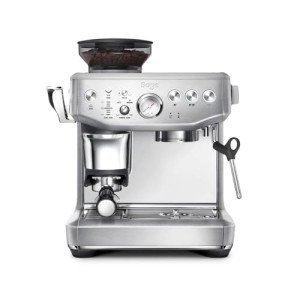Where Can You Find The Most Reliable Stainless Steel Espresso Machines Information?
The Art of Italian Espresso Machines: A Brewed Tradition
Italian espresso machines are not simply home appliances; they are an essential part of Italy's abundant coffee culture, representing a blend of artistry, engineering, and design. Coffee enthusiasts around the world acknowledge the significance of high-quality espresso, a staple of Italian life and cuisine. This article checks out the history, mechanics, types, and aspects to think about when purchasing an Italian espresso machine, reflecting the depth of this beloved beverage and its brewing techniques.
History of Espresso Machines
The espresso machine's advancement go back to the early 20th century in Italy, where coffee was not merely a drink but an important social routine. The initial efforts to brew espresso started with basic, stove-top designs, slowly evolving into complex machines that could duplicate the best brew.
- 1901— The First Espresso Machine: The first steam-powered espresso machine, called the “Ideale,” was established by Luigi Bezzera. This machinery marked a turning point in espresso brewing.
- 1938— The Lever Machine: The intro of the lever machine made it easier to manage the pressure used in espresso extraction, enhancing flavor consistency.
- 1947— The Automatic Machine: Reaching more consumers, Gaggia introduced the first automatic espresso machine, more promoting espresso bars.
- 2007— The Digital Age: Technological developments caused the birth of completely programmable machines, permitting users to tailor their brewing settings to accomplish an individualized coffee experience.
Secret Features of Italian Espresso Machines
Italian espresso machines embody precision, workmanship, and development. Here are some essential components that highlight their significance:
Feature
Description
Boiler Type
Determines how heat is produced and maintained. Common types include single boiler, dual boiler, and heat exchanger.
Group Heads
Where the coffee is brewed; commercial machines typically have multiple group heads for efficiency.
Pressure Control
Important for achieving the perfect espresso; most machines run at 9 bars of pressure.
Frothing Capabilities
The steam wand permits for milk frothing, vital for drinks like cappuccino and latte.
Develop Quality
The products utilized (stainless steel, brass, etc) influence resilience and heat retention.
Types of Italian Espresso Machines
Picking the ideal machine depends upon user choices, budget, and planned use. Below are the main types of Italian espresso machines:
Manual Espresso Machines
- Pros: Offer complete control over the brewing procedure, enabling a customized touch.
- Cons: Require skill and practice, can be labor-intensive.
Semi-Automatic Machines
- Pros: Provide a balance between automated and manual procedures; users manage water circulation.
- Cons: Can have a steeper learning curve than fully automatic machines.
Completely Automatic Machines
- Pros: Simplify the developing process with push-button operations; ideal for novices.
- Cons: May compromise a few of the nuances of manual developing.
Super-Automatic Machines
- Pros: Grind, tamp, brew, and froth automatically; convenient for hectic way of lives.
- Cons: Less control over the developing variables, capacity for a less authentic espresso experience.
Purchasing Guide: Factors to Consider
Selecting the ideal Italian espresso machine can be overwhelming, but thinking about the following elements can streamline the decision-making process:
- Budget: Italian espresso machines range from affordable to high-end models, so set a budget upfront.
- Use Frequency: Evaluate how typically you will use the machine; everyday users may want a more long lasting choice.
- Area: Measure your kitchen area or counter area; some machines can be large and need adequate clearance.
- Upkeep: Consider ease of cleansing; machines with detachable parts or integrated cleansing features may decrease upkeep.
- User Skill Level: Beginners may prefer totally or semi-automatic machines, while skilled baristas can handle manual machines.
- Brand name Reputation: Research brands understood for quality, such as Breville, Gaggia, and La Marzocco.
Popular Italian Espresso Machine Brands
Italian workmanship is renowned for producing some of the best espresso machines worldwide. Here are top brands worth thinking about:
- Gaggia: Known for its home espresso machines and price.
- La Marzocco: A premium brand name understood for its commercial-grade machines and innovative technology.
- Rancilio: Renowned for its long lasting develop and professional-quality machines ideal for home and commercial use.
- Sage/Breville: Offers advanced features and user-friendly styles, ideal for both amateurs and lovers.
FAQs
What is the difference in between espresso and routine coffee?
Espresso is a focused coffee brewed by forcing warm water through finely-ground coffee under pressure. It has a thicker consistency, richer taste, and higher caffeine concentration than regular coffee.
Can I make milk-based drinks with an espresso machine?
Yes, many Italian espresso machines feature a steam wand to froth milk for drinks like cappuccinos, lattes, and macchiatos.
How typically should I clean my espresso machine?
Regular upkeep is necessary. Normally, Buy Espresso Online is recommended every few weeks, while descaling needs to be done every 1 to 3 months, depending on water hardness.
What is the perfect pressure for developing espresso?
The perfect pressure for developing espresso is around 9 bars. This pressure ensures the optimum extraction of flavors from the coffee grounds.
Are more costly machines worth the investment?
Higher-end machines frequently make use of much better materials and technology, supplying enhanced resilience and more constant outcomes. For serious coffee fans, investing in a good machine can raise the espresso experience significantly.
Italian espresso machines are far more than mere brewing devices; they are an event of a cultural tradition that has affected coffee intake worldwide. With Top Espresso Machines to fit any user's needs— varying from novices to seasoned baristas— there is an Italian espresso machine completely matched for everyone. As you start your espresso journey, comprehending the history, mechanics, and choices will enhance your experience and appreciation for this time-honored beverage. Whether you seek to recreate a café ambiance in the house or refine your brewing method, these machines are capable of delivering memorable cups of espresso adorned with the abundant history of Italian coffee culture.
